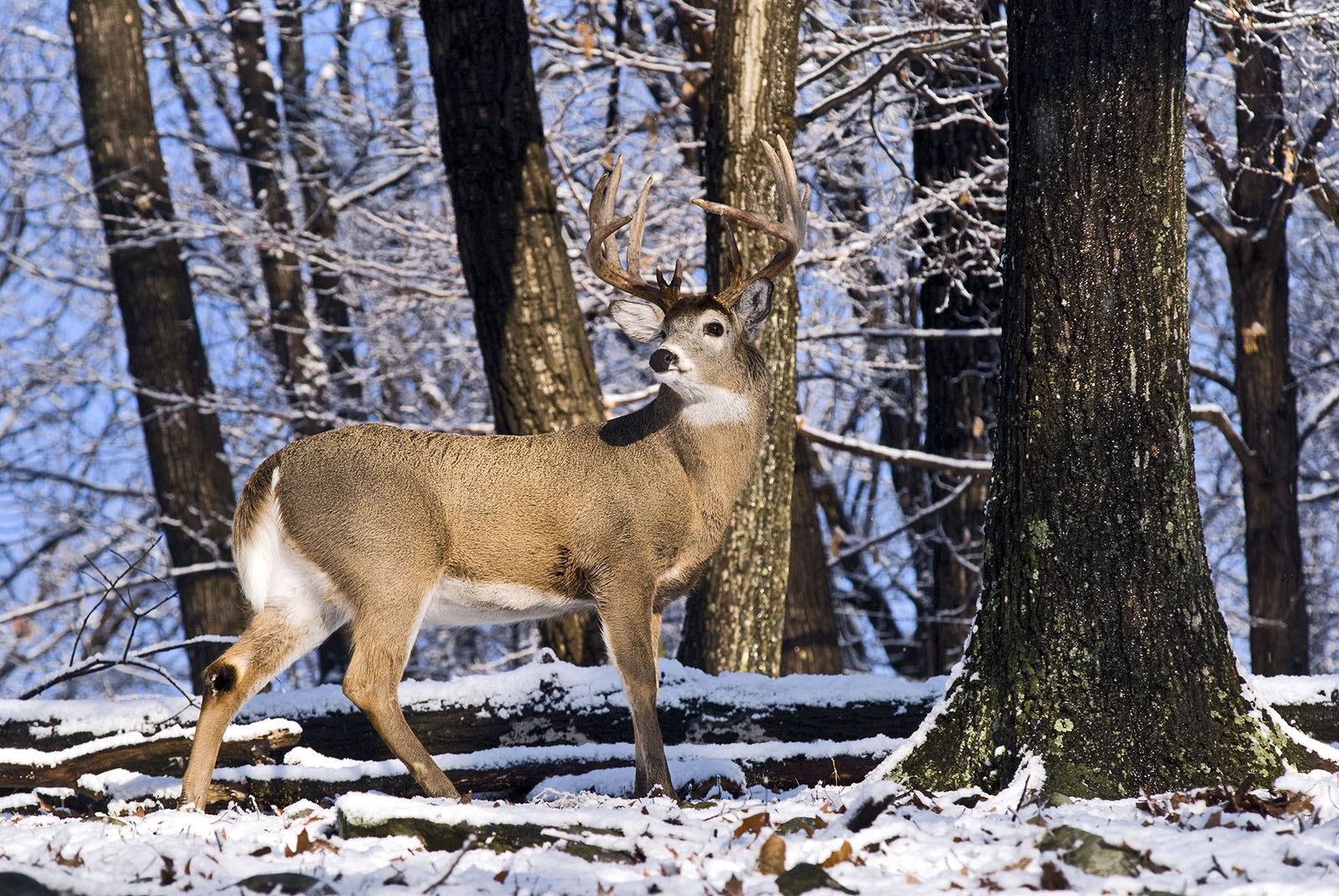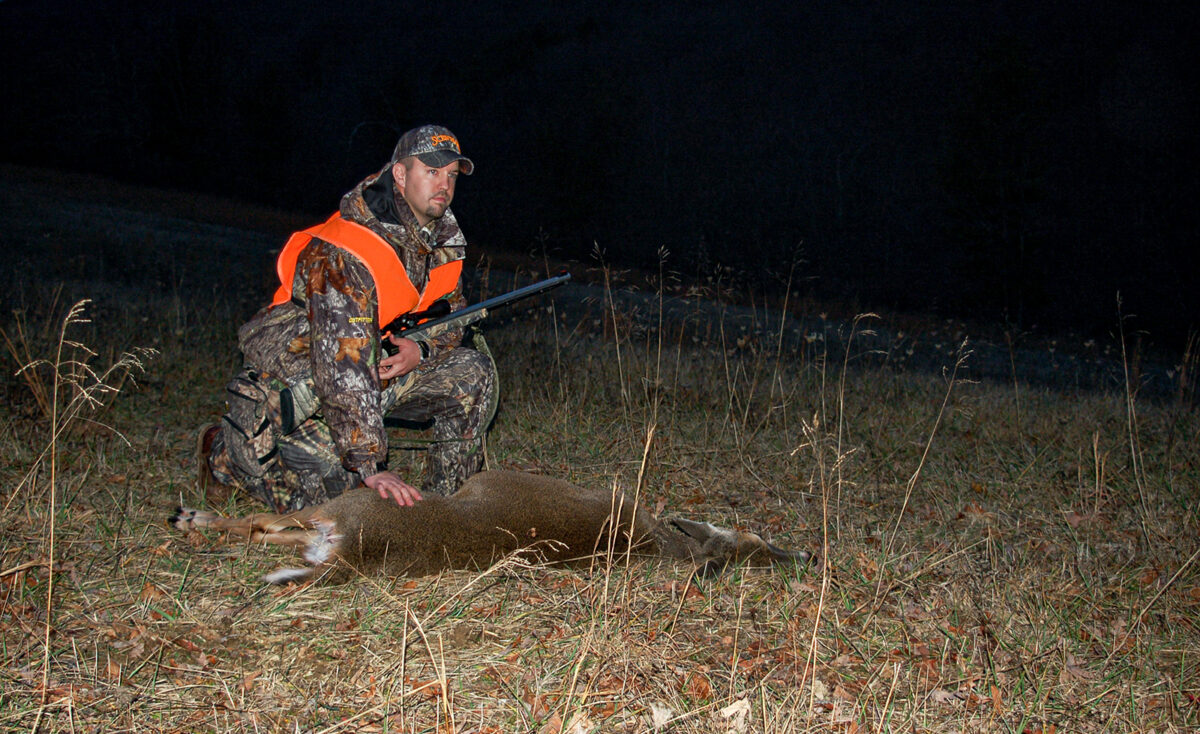By Bruce Ingram for Whitetail Times
It was the first Saturday in January and the last day of both the bow and late muzzleloader seasons. With a goal of putting one more doe in the freezer, I considered my options. Among them were bringing a smokepole and taking a stand overlooking a Botetourt County cow pasture or a mountain hollow down Route 220 a few miles. Or I could carry a crossbow and hunt behind my house from a ladder stand or venture to a nearby patch of habitat where a few chestnut oak acorns still littered the ground and where some dried persimmons and summer grapes still clung to limbs and vines respectively.
I chose the last option because, well, sometimes we deer hunters just play a hunch that leads us to a certain locale. As soon as dawn broke, whitetails began to filter through the little postage stamp of a place. A forkhorn and a four-pointer appeared first and eventually drifted away. Even when they were within 10 yards of my blind, I was looking beyond the duo in order to hopefully glimpse what might be strolling toward me next.
And soon after the young bucks disappeared, a pair of does ambled into the clearing and my pulse quickened. I moved the crossbow forward so that the tip of the arrow cleared the blind’s window, centered the sights on the lead doe’s boiler room, and slowly pressed the release. I knew the hit was a good one by the way the whitetail nearly collapsed when hit, and the crash I heard a few seconds later confirmed that a short period of trailing was all that would be required.
Hunters go afield for various reasons during the late archery and gun seasons. Some, like me, want one more doe for the freezer, some just enjoy being outside, and others want the experience of taking a big buck. What should their expectations be? Katie Martin, the deer, bear, and turkey biologist for the Virginia Department of Wildlife Resources (DWR), gives insight on just what folks who have those goals can expect.

Late season deer hunters often incur some of the toughest weather conditions that Mother Nature has to offer. However, hunters that locate prime food sources in the late season and hunt those sites will greatly increase their chances for success. Photo by Dr. Leonard Lee Rue III
“The late season is probably the most challenging time of the entire deer season to kill a big buck,” she said. “The deer have been pressured for months and older bucks aren’t as likely to come out much during the daytime. The deer that do move before dark will be looking for food, so the best plan is to set up in a travel corridor between a bedding area and a late-season food source.
“But, again, the odds of killing a nice buck aren’t as high as they were during the peak of the rut. Food becomes the name of the game during the late season, and patterning an animal during the latter part of the season is tough after they’ve had several months of hunting pressure on them. The main purposes of Virginia late seasons are to give hunters a chance to get outside and enjoy the outdoors and for a few more does to be harvested.”

This past season in late December, I found a massive, fresh rub on a white pine on my Botetourt land—something that occurs nearly every winter. Would I have had a realistic chance of patterning that buck and killing it?
“Realistically, probably not,” Martin said. “It’s not unusual to see late rubs because a few stray does have come back into estrous. Any property could have a doe or two that for whatever reason were not bred during the rut. But you have to also understand that the bucks themselves are stressed and worn out from the rut. Their endurance is much less now, and they’re likely much more interested in feeding and recovering from the rut.”
To me, one of the most fascinating aspects of whitetail biology is fawn behavior during the late season. From various sources, I’ve read that somewhere between 15 and 20 percent of doe fawns breed their first year and they have to achieve a certain weight to do so. Other sources have that percentage higher—and lower. What is the situation in the Old Dominion?
“For a fawn to breed, she would probably have to be of a good size, in very good condition, and have been born earlier in the spring,” Martin said. The vast majority of Virginia fawns are born in late May and early June. Every year, we have a few reports of fawns being born in July, in early May and even in mid-April.
“An April fawn would certainly have a better chance to breed than a July one, but April-born fawns are pretty rare,” said Martin. “Based on yearling lactation rates, fawn breeding can vary from 0 to 40 percent in a given county, but averages around 12 percent statewide. So counting on a fawn to come into estrous to help a hunter locate a big buck during the late season isn’t a very high probability.”
Think Food
So what can late season Virginia hunters do to improve their chances of success, regardless of what their hunting goals are? Martin believes that habitat improvement projects can certainly help.
“Late-season deer browse on a wide variety of plants,” she said. “If hunters had earlier created places that have soft edges and hinge cuts where deer can feed on stems and twigs, they’re more likely to see deer. I would suggest setting up near thick, early successional areas that adjoin a good food source.
“Food plots that have been planted in things like sugar beets, turnips, and various cover crops would also be good places to check out along with soft mast-producing species such as persimmons, which can hold fruit late into the season. Agricultural fields with standing crops (corn, grain sorghum) or in cover crops of wheat or rye can also be great places to target. A few acorns from chestnut oak and red oak family members could possibly still be around. Greenbrier and honeysuckle are popular browse items, too. And any early successional habitat would be worth checking out, too.”

Hunting a cut-over is another sound late-season strategy. Deer often bed in clear cuts for warm sunlight on cold winter days. Rifle hunters that pay attention to the wind and watch these areas from afar can benefit from this tactic. Photo by Bruce Ingram
Martin added that deer are instinctively aware that fruitlessly moving about in cold weather is not energy efficient, so this big game animal often beds for longer periods of time now. Pine and red and white cedar groves that offer mature trees can provide outstanding thermal cover where deer will hunker down during snowfalls, ice storms, and intense cold.
During my discussion with Martin, I mentioned that although I have harvested several early-morning deer during the late season (such as the doe mentioned earlier) I generally don’t go afield at dawn now. In fact, one of my favorite times to hunt is between 11:00 a.m. and 1:00 p.m. Martin agreed that there often seems to be mid-day movement during mid-to-late December and early January. The deer elect not to move during the often-frigid conditions of early morning, instead waiting until the thermometer moves upward at mid-day.
One aspect of deer movement does not seem to change during the late season. I keep records of every deer I kill and every whitetail I see, and the best time to be afield (as is often the case earlier in the season) is the last 90 minutes of shooting light. That’s why I like to be at a stand as early as 3:00 p.m. then. And if a warm front is occurring, I’ll go on stand at 11:00 and stay until sundown.
How-to Tips
Virginia Deer Hunters Association (VDHA) member Jeff Phillips operates the popular website and Facebook page Star City Whitetails from his Roanoke home. Phillips offers this game plan for the late season.
“I really enjoy the late bow and muzzleloader seasons,” he said. “The November gun seasons are the bread and butter of many hunters, so there is much less hunting pressure now. For me, the most important thing to accomplish is to find out what the food sources are. Both the bucks and the does are trying to replenish themselves and recover from the rut. So anything that is green will draw them, especially if the acorns are all gone.”
That green vegetation, continued Phillips, could include such atypical deer foods as azaleas, ground ivy, shrubbery, and pine and cedar needles, as well as typical ones such as honeysuckle and still green fields and other openings. The Roanoker also acknowledges that taking a big buck is possible now.
“Every December I see bucks chasing does,” he said. “And I’ve killed big bucks in the late December to early January period. But you have to be at right place—again, something green—at the right time and have the right doe and buck come by. It happens, but it isn’t easy. That said, I 100 percent think it’s best to concentrate on food sources. Day to day, deer movement now will be dictated by their stomachs—especially after the rut.”
Phillips said that one of the most rewarding bucks he has ever harvested was shot with a muzzleloader on the last day of the 2015 season. He aged the deer at 6 ½ years, had captured it on trail cameras for years, and had hunted the Roanoke County property where he tagged the mossyhorn some 200 times during its lifetime. Yet, he had never glimpsed the creature.
“About an hour before dark that day, two does came out into a green field,” Phillips recalled. “They kept looking back and then I saw why—it was the big buck I knew lived there but had never seen. Right before he came into the field, he stared right at the blind box I was sitting in 50 yards away and that had been there for four years.
“Finally, he stepped all the way out, and I dropped him. His eight-point rack is nothing special, but I’m one that believes that a buck’s age is the trophy, and he’s the oldest deer I’ve ever killed.”
VDHA member Jim Crumley went afield only with a bow for 50 consecutive years from the ages of 21 to 71. The now 75-year-old Botetourt County resident has hunted with a muzzleloader, rifle, crossbow, and compound the last four years. I asked him for advice on how to hunt the late season.
“I’ve only killed two trophy late season bucks in all my years of hunting,” he says. “I agree with Katie Martin about how difficult it is to be successful then. I think it’s a doggone good deal to even kill a doe in December and early January. Occasionally, I see small bucks chasing does then, but that’s about it.
“So, my advice is to find the local, hot food source. On our land, sometimes it’s grapes, sometimes its persimmons. One year, I saw deer feeding on blackberry vines,” said Crumley. “And if you get a chance to harvest a doe, take it and be proud of your accomplishment.”
Bruce Ingram, a serious whitetail hunter and fisherman, lives in Fincastle, Virginia with his family. His hunting and fishing articles have been published in state, regional and national publications.
©Virginia Deer Hunters Association. For attribution information and reprint rights, contact Denny Quaiff, Executive Director, VDHA.



